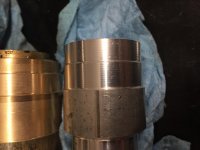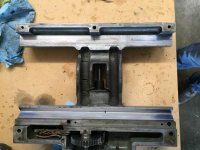I have been rebuilding a 1950s Sebastian 13" gear head lathe for sometime and I am 90% complete with the rehab. Just as a quick rundown, I rebuilt the apron (mostly cleaning and a few bronze bushings), I reconditioned the speed and feed gearbox (Couple of replacement gears, and a new phenolic gear), and I repainted the whole thing. Everything works great except I get a pattern almost like a spool of thread in all my cuts, independent of the lathe speed,tooling or the feed rate. I have isolated the problem to the spindle. I used a few other posts to trouble shoot and eliminate other possible issues. I have tried the following...
The lathe is level, with a calibrated machinist level.
New Belts, New Pulleys (solid steel, balanced, and trued) The Shaft on motor is running true.
I checked a wide range of feeds, speeds, and even hand feeding at a constant rate to eliminate the apron, and feed selectors.
Different cutting tools, all sharp
I went so far as to take the spindle out of gear, and turn just the spindle with a drill, using the feeding on the apron and feeding by hand.
And all of that I still have the pattern. I also have a slight vibration in the lathe at high speeds but I have triple check the feet and the leveling. I also have access to another machine that is almost an exact clone of mine and it doesn't suffer from the same problem with the vibration or the patterning.
So I have tried my best with the help of everyone here to eliminate all possible issues other than the spindle bearings. So now I am to the spindle. Today I removed the spindle which came out like a dream mostly to clean it but also to get a look at the bearing cup and cone. At first glance they look really good. But in a certain light they have a wavy shimmer. You can't feel the pattern but you can see it. Both bearings cups show something similar. I cleaned every surface thoroughly and reassembled the spindle and checked the preload on the bearings and would you believe the pattern is still there.
Has anyone seen this before? I can get a Class 0 rear bearing, but the front bearing is almost impossible to find in a class 0... so much so I can't find one. Should I replace the back and see if that helps? Or am I likely to ruin a 650$ bearing.




The lathe is level, with a calibrated machinist level.
New Belts, New Pulleys (solid steel, balanced, and trued) The Shaft on motor is running true.
I checked a wide range of feeds, speeds, and even hand feeding at a constant rate to eliminate the apron, and feed selectors.
Different cutting tools, all sharp
I went so far as to take the spindle out of gear, and turn just the spindle with a drill, using the feeding on the apron and feeding by hand.
And all of that I still have the pattern. I also have a slight vibration in the lathe at high speeds but I have triple check the feet and the leveling. I also have access to another machine that is almost an exact clone of mine and it doesn't suffer from the same problem with the vibration or the patterning.
So I have tried my best with the help of everyone here to eliminate all possible issues other than the spindle bearings. So now I am to the spindle. Today I removed the spindle which came out like a dream mostly to clean it but also to get a look at the bearing cup and cone. At first glance they look really good. But in a certain light they have a wavy shimmer. You can't feel the pattern but you can see it. Both bearings cups show something similar. I cleaned every surface thoroughly and reassembled the spindle and checked the preload on the bearings and would you believe the pattern is still there.
Has anyone seen this before? I can get a Class 0 rear bearing, but the front bearing is almost impossible to find in a class 0... so much so I can't find one. Should I replace the back and see if that helps? Or am I likely to ruin a 650$ bearing.







